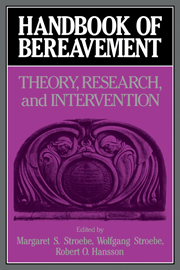Book contents
- Frontmatter
- Contents
- Contributors
- Preface
- Part I Introduction
- Part II The phenomenology and measurement of grief
- Part III Current theories of grief, mourning, and bereavement
- Part IV Physiological changes following bereavement
- Part V The psychological, social, and health impacts of conjugal bereavement
- Part VI Grief reactions to different types of loss
- Part VII Coping, counseling, and therapy
- 23 The meaning of loss and adjustment to bereavement
- 24 Old age and widowhood: Issues of personal control and independence
- 25 The support systems of American urban widows
- 26 The role of social support in bereavement
- 27 Bereavement self-help groups: A review of conceptual and methodological issues
- 28 Counseling and therapy of the bereaved
- Part VIII Conclusions
- References
- Author index
- Subject Index
28 - Counseling and therapy of the bereaved
Published online by Cambridge University Press: 04 May 2010
- Frontmatter
- Contents
- Contributors
- Preface
- Part I Introduction
- Part II The phenomenology and measurement of grief
- Part III Current theories of grief, mourning, and bereavement
- Part IV Physiological changes following bereavement
- Part V The psychological, social, and health impacts of conjugal bereavement
- Part VI Grief reactions to different types of loss
- Part VII Coping, counseling, and therapy
- 23 The meaning of loss and adjustment to bereavement
- 24 Old age and widowhood: Issues of personal control and independence
- 25 The support systems of American urban widows
- 26 The role of social support in bereavement
- 27 Bereavement self-help groups: A review of conceptual and methodological issues
- 28 Counseling and therapy of the bereaved
- Part VIII Conclusions
- References
- Author index
- Subject Index
Summary
Caring for bereaved people involves a wide range of interventions, from the compassionate and empathic communication of a terminal illness diagnosis through the in-depth psychiatric management of bereaved people whose grief may or may not have contributed to their illness. There is also a powerful social movement of care that has evolved, particularly in the last three decades, recognizing the needs of, and supporting, bereaved people. Associated with this has been the development of self-help organizations that have contributed to the care and counseling of the bereaved. There are now many studies describing the effects of bereavement on health and wellbeing and the interventions that may be provided to prevent or deal with pathological outcomes. Still, there is much to be learned.
The models that have been used for counseling the bereaved have arisen for the most part from psychotherapeutic approaches and have traditionally applied to the one-to-one situation, with some extension to family and group treatments. Horowitz has been a significant contributor in defining the psychotherapeutic approach for grief (Horowitz et al., 1984a), dealing with bereavement in the context of stress response syndromes; other workers (Lindemann, 1944; Raphael, 1977, 1983) have utilized psychodynamic understanding for crisis intervention formats. Behavioral therapies have also been utilized, and descriptions have ranged from the broad model of Ramsay (1979), to the specifics of guided mourning (Mawson et al., 1981), to a more recent conceptualization that is cognitively oriented (Kavanagh, 1990).
- Type
- Chapter
- Information
- Handbook of BereavementTheory, Research, and Intervention, pp. 427 - 454Publisher: Cambridge University PressPrint publication year: 1993
- 28
- Cited by



